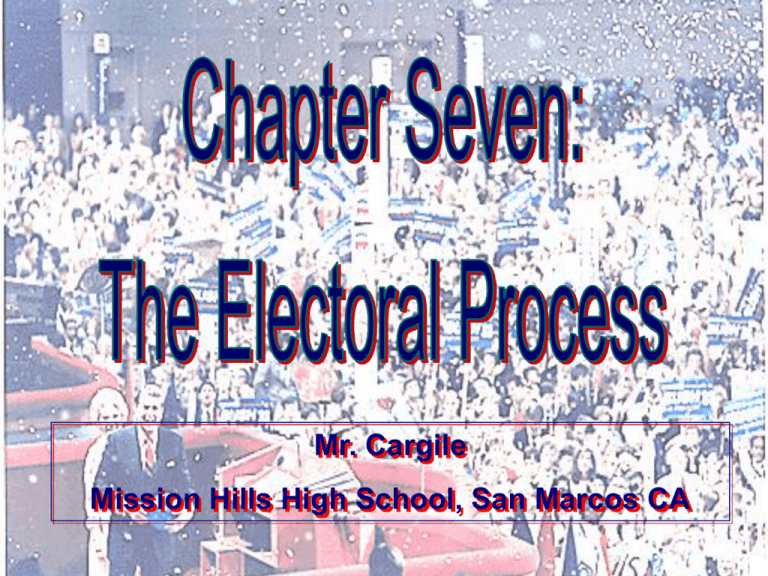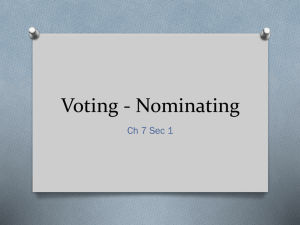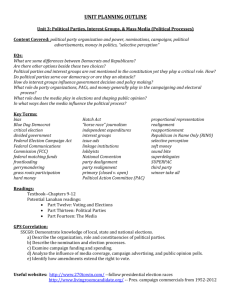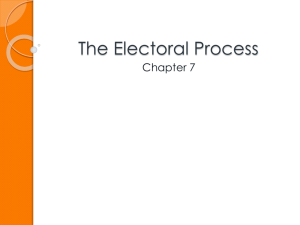Chapter 7, Section 1 - San Marcos Unified School District
advertisement

Presentation Pro Mr. Cargile Mission Hills High School, San Marcos CA CHAPTER 7 The Electoral Process SECTION 1 The Nominating Process SECTION 2 Elections SECTION 3 Money and Elections Go To Section: 1 2 3 Chapter 7 SECTION 1 The Nominating Process • Why is the nominating process a critical first step in the election process? • What are self-announcement, the caucus, and the convention nominating methods? • Why is the direct primary the principal nominating method used in the United States today? • Why do some candidates use the petition as a nominating device? Go To Section: 1 2 3 Chapter 7, Section 1 A Critical First Step In the United States, the election process occurs in two steps: 1. Nomination (Primary Election), in which the field of candidates within a party is narrowed to the one candidate the entire party supports against the opposition’s candidate 2. General election, the regularly scheduled election where voters make the final choice of officeholder Go To Section: 1 2 3 The oldest method of the nominating process 1. Self-Announcement • A person who wants to run for office announces their candidacy. • Whenever a write-in candidate appears on the ballot, the self-announcement process has been used. 2. The Caucus • Originally a private meeting of local bigwigs. • The caucus as a nominating device fell out of favor in the 1820s. • Still used in a few states but party members are invited to participate. Go To Section: 1 2 3 3. The Convention • • Considered more democratic than the caucus, convention delegates were selected to represent the people’s wishes. Soon became corrupt and the convention system was on its way out by the early 1900s. 4. Direct Primary • An election held within the party to narrow the field of candidates to one for the general election. Go To Section: 1 2 3 5. Petition • • • Candidates must gather a required number of voters’ signatures to get on the ballot by means of petition. Minor party and independent candidates are usually required by State law to be nominated by petition. Petition is often used at the local level to nominate for school posts and municipal offices. Go To Section: 1 2 3 1790 to 1828 Caucus---small group of individuals who would choose a candidate 1828 to 1900 Convention---members from the political parties nominate a candidate Current System Used Direct Primary---allow registered voters to participate in choosing a candidate Which of these nominating processes would be the most democratic way to nominate candidates and narrow the field of candidates Go To election? 1 the 2 general 3 Section:for Direct Primary An election held within the party to narrow the list of candidates to one who will run against the opposing party’s candidate in the general election. Types of Direct Primaries Closed Primary Open Primary Only declared party members can vote. Any qualified voter can take part. President, governor and state officials Go To Section: 1 2 3 Runoff Primary If a required majority is not met, the two people with the most votes run again Nonpartisan Primary Candidates are not identified by party labels School Board members 1. 2. 3. Go To Section: 1 2 3 CANDIDATES ANNOUNCE THEIR CANDIDANCY USUALLY A YEAR OR MORE BEFORE THE GENERAL ELECTION PRIMARY ELECTIONS IN EACH STATE ARE USUALLY HELD 3 to 6 MONTHS BEFORE THE GENERAL ELECTION STATE PRIMARIES NARROW THE CANDIDATES TO ONE FOR EACH PARTY Chapter 7, Section 1 CHRONOLOGY Go To Section: 1 2 3 4. POLITICAL PARTIES HOLD NATIONAL CONVENTIONS TO OFFICIALLY NOMINATE THEIR CANDIDATE FOR THE GENERAL ELECTION 5. CANDIDATES FOR EACH OFFICE CAMPAIGN AGAINST ONE ANOTHER AFTER LABOR DAY 6. GENERAL ELECTION IS HELD IN NOVEMBER, ON THE FIRST TUESDAY AFTER THE FIRST MONDAY ON EVEN YEARS, EVERY 2 YEARS. Chapter 7, Section 1 CHRONOLOGY Three Ways to Nominate Self-Announcement – A person who wants to run for office announces their candidacy. Whenever a write-in candidate appears on the ballot, the self-announcement process has been used. The Caucus – Originally a private meeting of local bigwigs, the caucus as a nominating device fell out of favor in the 1820s. The Convention – Considered more democratic than the caucus, convention delegates were selected to represent the people’s wishes. Party bosses soon found ways to manipulate the system, however, and the convention system was on its way out by the early 1900s. Go To Section: 1 2 3 Chapter 7, Section 1 Primaries Across the United States Go To Section: 1 2 3 Chapter 7, Section 1 Petition • Candidates must gather a required number of voters’ signatures to get on the ballot by means of petition. • Minor party and independent candidates are usually required by State law to be nominated by petition. • Petition is often used at the local level to nominate for school posts and municipal offices. Go To Section: 1 2 3 Chapter 7, Section 1 1. In a closed primary: (a) All qualified voters can vote (b) Only declared party members may vote (c) Voters must vote a split ticket (d) Voters must complete separate ballots for both parties 2.The most commonly used method of nomination today is (a) the caucus. (b) the direct primary. (c) self-announcement. (d) the convention. 2. A runoff primary is held in some States when (a) no one wins a majority of votes. (b) there is only one candidate. (c) not enough voters turn out on election day. (d) a candidate asks for a recount. Go To Section: 1 2 3 Chapter 7, Section 1 SECTION 2 Elections • How does the administration of elections in the United States make democracy work? • What role do precincts and polling places play in the election process? • In what ways can voters cast their ballots? • What role do voting machines and other innovations play in the election process? Go To Section: 1 2 3 Chapter 7, Section 2 The Administration of Elections Elections are primarily regulated by State law, but there are some overreaching federal regulations. Congress has the power to set the time, place, and manner of congressional and presidential elections. Congress has chosen the first Tuesday after the first Monday in November of every even-numbered year for congressional elections, with the presidential election being held the same day every fourth year. Go To Section: 1 2 3 States determine the details of the election of thousands of State and local officials. Most States provide for absentee voting, for voters who are unable to get to their regular polling places on election day. Some States within the last few years have started to allow voting a few days before election day to increase voter participation. Chapter 7, Section 2 Precincts and Polling Places Precincts • • • A precinct is a voting district. Precincts are the smallest geographic units used to carry out elections. A precinct election board supervises the voting process in each precinct. Go To Section: 1 2 3 Polling Places • • A polling place is where the voters who live in a precinct go to vote. It is located in or near each precinct. Polling places are supposed to be located conveniently for voters. Chapter 7, Section 2 Casting the Ballot History of the Ballot • • • Voting was initially done orally. It was considered “manly” to speak out your vote without fear of reprisal. Paper ballots began to be used in the mid-1800s. At first, people provided their own ballots. Then, political machines began to take advantage of the flexibility of the process to intimidate, buy, or manufacture votes. In the late 1800s, ballot reforms cleaned up ballot fraud by supplying standardized, accurate ballots and mandating that voting be secret. Go To Section: 1 2 3 Chapter 7, Section 2 Printed at public expense Lists names of all candidates and their parties Go To Section: 1 2 3 Chapter 7, Section 2 Given out only at the polls By highlighting the office, rather than the party, an office-group ballot encourages splitticket voting. How does a party-column ballot encourage voters to vote along party lines? Vote in secret Go To Section: 1 2 3 Chapter 7, Section 2 Voting Machines and Innovations • • Electronic vote counting has been in use sinceActivity [10-mins.] Paired the 1960s. Punch-card 1. Open to page 195. ballots areyour oftentextbooks used to cast votes. 2. Read Face the Issues (Electronic Voting) Vote-by-mail elections and answer the questions. have come into use in 3. Write the questions and answers in your recent years. • notes. Online voting is a trend that may be encountered in the near future. Go To Section: 1 2 3 Chapter 7, Section 2 1. Elections are held on (a) the first Wednesday after Halloween. (b) the first Tuesday after the first Monday in November. (c) the second Thursday after the first Monday in March. (d) the first Monday in December. 2. The Office-Group Ballot encourages (a) voter fraud. (b) split-ticket voting. (c) voter dissatisfaction. (d) the Democratic Party. Go To Section: 1 2 3 Chapter 7, Section 2 SECTION 3 Money and Elections • What are the issues raised by campaign spending? • What are the various sources of campaign funding? • How do federal laws regulate campaign finance? • What role does the Federal Election Commission have in enforcing campaign finance laws? • What loopholes exist in today’s campaign finance laws? Go To Section: 1 2 3 Chapter 7, Section 3 Campaign Spending What do you think are the most costly items in typical campaign budgets today are? (a)TV ads (b)Print ads (i.e. newspaper and magazine) (c)Travel and entertainment (d)Propaganda (i.e. pamphlets and posters) Go To Section: 1 2 3 Chapter 7, Section 3 Sources of Funding Private and Public Sources of Campaign Money PACs are groups What exactly set up to generateSmall large amounts of money for contributors are PACs? campaign contributions Nonparty groups such as PACs Wealthy supporters Temporary fund-raising organizations Candidates Government subsidies Go To Section: 1 2 3 Chapter 7, Section 3 Regulating Campaign Financing • • • • • Early campaign regulations were created in 1907, but feebly enforced. The Federal Election Campaign Act (FECA) of 1971 was passed to replaced the former, ineffective legislation. The FECA Amendments of 1974 were passed in response to the Watergate scandal. Buckley v. Valeo invalidated some of the measures in the FECA Amendments of 1974. Most significantly, it also stipulated that several of the limits that the 1974 amendments placed on spending only apply to candidates who accept campaign money from the government, not those who raise money independently. The FECA Amendments of 1976 were passed in response to Buckley v. Valeo. Go To Section: 1 2 3 Chapter 7, Section 3 The Federal Election Commission The Federal Election Commission (FEC) enforces: • the timely disclosure of campaign finance information • limits on campaign contributions • limits on campaign expenditures • provisions for public funding of presidential campaigns Go To Section: 1 2 3 Chapter 7, Section 3 Loopholes in the Law “More loophole than law…” —Lyndon Johnson • • • Soft money—money given to State and local party organizations for “party-building activities” that is filtered to presidential or congressional campaigns. $500 million was given to campaigns in this way in 2000. Independent campaign spending—a person unrelated and unconnected to a candidate or party can spend as much money as they want to benefit or work against candidates. Issue ads—take a stand on certain issues in order to criticize or support a certain candidate without actually mentioning that person’s name. Go To Section: 1 2 3 Chapter 7, Section 3 1. Sources of campaign funding include (a) nonparty groups, such as political action committees. (b) government subsidies. (c) candidates’ personal funds. (d) all of the above. 2. Under federal election legislature passed in the 1970s, candidates are not allowed to (a) take government subsidies. (b) use their own money in campaigns. (c) take contributions of more than $1,000. (d) all of the above. Go To Section: 1 2 3 Chapter 7, Section 3






